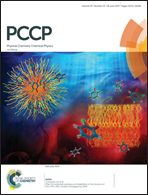Reliable nanometre-range distance distributions from 5-pulse double electron electron resonance†
Abstract
Double electron electron resonance (DEER) enables determination of distance distributions in the nanometre range. A recently introduced 5-pulse version of this experiment prolongs the electron spin coherence lifetime and thus provides improved sensitivity or an extended distance range, but suffers from artefacts due to partial excitation and excitation band overlap. In particular, the partial excitation artefact is hard to eliminate experimentally at frequencies where DEER is most sensitive or on spectrometers that provide only monochromatic pulses. Here, a data post-processing method is introduced that removes the partial excitation artefact without relying on previous knowledge of its amplitude and without sensitivity loss. The method is based on acquisition of two traces with shifted positions of the artefact and computation of the artefact shape from the difference of the two traces. Artefact removal was successfully tested both on simulated and experimental data. It was found to be stable for a variety of distance distributions and down to low signal-to-noise ratios in the presence of moderate background decay. The artefact correction method also performs well in the regime of rather strong partial excitation artefacts that is usually encountered with rectangular monochromatic pump pulses on widely available commercial spectrometers.

- This article is part of the themed collection: 2017 PCCP HOT Articles


 Please wait while we load your content...
Please wait while we load your content...